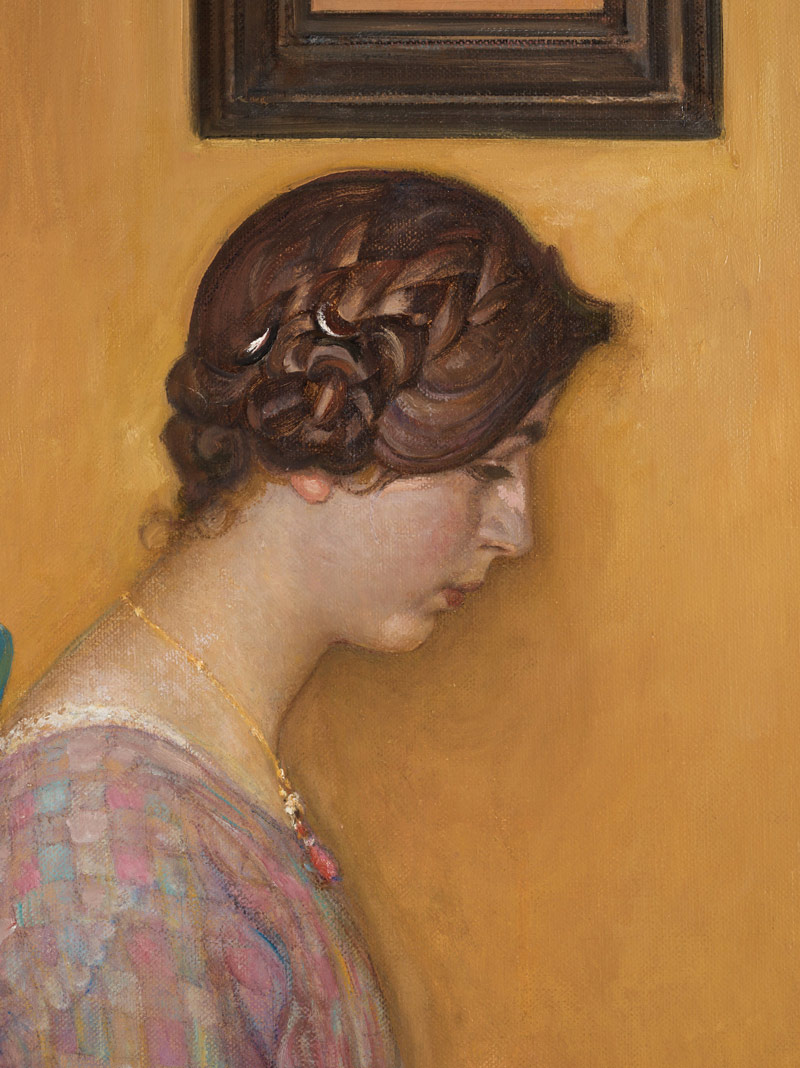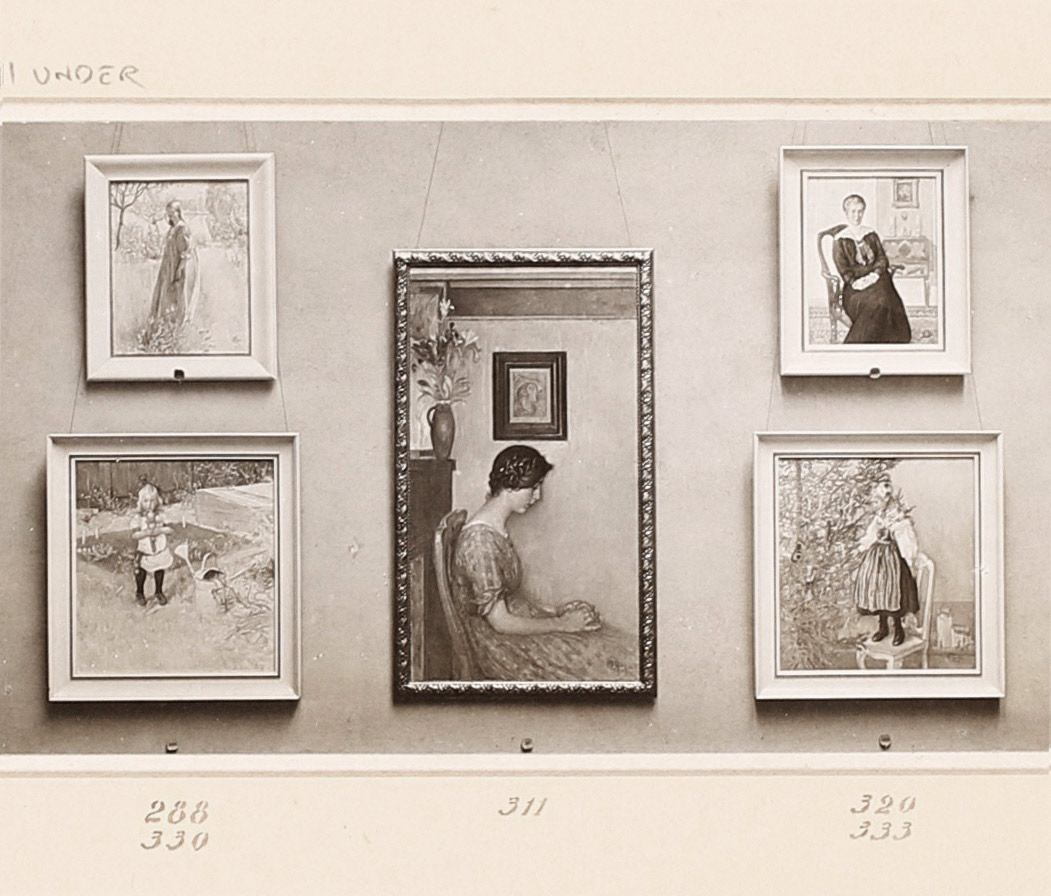Important Winter Sale: Carl Larsson ”Kersti 19 år”
Carl Larsson
”Kersti 19 år”
Background, 1914-15
Ulwa Neergaard gives the following description in her book about Carl Larsson: “On the 1st of March 1914, Carl Larsson had resigned from his commission to decorate the last remaining wall space by the staircase at the National Museum. Instead, he decided to take a risk and paint Midvinterblot [Midwinter sacrifice] and in May that year he put up the almost fourteen-metre long canvas around the walls of his studio in Sundborn. From this point on he is entirely devoted to Midvinterblot”. The work took up all of his time and demanded resources. Models, canvases and paint were costly, and in addition to this, he made trips in order to do detailed studies. A stable source of income, however, was the commissions from Fritzes Kungliga Bokhandel, whose clients wanted watercolours and life studies.
Midvinterblot was first exhibited in June 1915 at the National Museum. The criticism was unbelievably harsh and the reception of Midvinterblot has been described as a personal tragedy for Carl Larsson. The imagery, with a naked king sacrificing himself at Uppsala temple for the good of the people, was considered inappropriate and not befitting the National Museum. “The fate of Midvinterblot broke me! This I admit with subdued rage. Yet it was for the best, once again my intuition tells me that now – for this painting, with all its weaknesses, will be honoured with a far better place someday after I am gone.”
The year 1915
It is against this backdrop that we may view and interpret the painting in the auction, Kersti 19 år. The piece was executed in 1915 when Carl Larsson was in the middle of working on the momentous Midvinterblot. Studies for the painting were scattered throughout the studio, and melancholic thoughts and economic worries were weighing him down. The portrait of his youngest daughter Kersti, who was 19 at the time, was done in the so-called ‘Workshop’ at Lilla Hyttnäs. The room in question was originally used as his main studio, before his new, larger studio (the biggest one at that time in Sweden) was inaugurated on New Year’s Eve 1899. In connection with this Karin Larsson moved her looms into the old space, and it came to be known thereafter as the ‘Workshop’. The room, which also functioned as a living room for the whole family, is still today dominated by the yellow-coloured tongued, grooved and beaded panels on the walls and the green joinery. The interior was both unruly and practical. In one of the corners, there was a red-painted sofa, built into the wall, and a pillar containing a cabinet for paints. Above the sofa the glass painting Ett lustvandrande par i ett historiskt landskap hanged, depicting Karin and Carl Larsson (see photo from the Carl Larsson house).

› Signed C.L. within a circle and dated 1915. Inscribed verso ”Min dotter Kersti” and C.L. (My daughter Kersti). Canvas 143 x 81 cm. Estimate 3 000 000 – 4 000 000 SEK

In the present painting it is Kersti that is depicted, seated quietly in profile on one of the blue-painted 18th-century chairs. The chair has been placed in the corner against the side of the red-painted sofa, and we glimpse the glass painting to the left of a striking bouquet of flowers. Kersti is wearing a dress made by Karin. Her beautifully braided hair arrangement forms a pattern that is in harmony with the scrolling shapes of the bouquet and testifies to Carl Larsson’s unique talent in translating the language of lines. The picture hanging above Kersti’s head is a caricature and creates, with its black colouring and sharp frame, a contrasting effect to Kersti’s soft and billowing form and the sheer fabric of her dress. His otherwise so typical well-defined black outlining is subdued here. Instead, it is the burning ochre, which makes up the background and which frames Kersti in her contemplative position that creates the contrast. This generates a feeling of painterly warmth as opposed to Larsson’s more stylised work. In this almost pre-Raphaelite composition, there is not that exaggerated sentimentality for which Larsson was sometimes criticised. The strong colours and the bold format contribute to revealing Kersti 19 år as one of Larsson’s most modern paintings. Carl Larsson did not feel obliged to change his visual language in line with changing tastes in art, and he remained faithful to his artistic vision throughout his life. Little did he know that this love letter to his daughter would become a timeless work of art that is equally at home on the history-saturated walls of Lilla Hyttnäs as it is in a modern art gallery.

Inaugural exhibition at Liljevalchs konsthall
In March 1916 Liljevalchs Konsthall on Djurgården in Stockholm was opened. In their inaugural exhibition works by the three most prominent contemporary artists in Sweden were shown: Bruno Liljefors, Anders Zorn and Carl Larsson. It was an impressive exhibition that filled the spacious rooms of the new art gallery. In the exhibition catalogue, numbered ‘1’, we find 67 pieces by Bruno Liljefors, 134 pieces by Anders Zorn, and 135 pieces by Carl Larsson. All three artists showed a selection of work charting their development from the early 1880s up until 1916. The number of pieces that were made in the year before the exhibition is impressive, as many as twenty-three works by Carl Larsson were dated 1915 and a further two were dated 1916. Fifteen of these were oil paintings. On the long wall in the grand entrance hall the lower section of Midvinterblot was exhibited, in all its controversial glory. In one of the Carl Larsson rooms the painting in the auction, Kersti 19 år, hanged as a pendant to Kersti i Svärdsjödräkt, also painted in 1915. At the time of the exhibition, Dr Knut Barr described them as follows: “Kersti has inspired two pendants […], both belonging to the dearest and most lovingly worked of Carl Larsson’s later pieces”.

Kersti
Four years after having completed Kersti 19 år, Carl Larsson, one of Sweden’s greatest painters of all time, passed away at the age of 66. That same year Kersti met her husband-to-be Axel Frieberg, a lieutenant in the Dalarna Regiment. They were married in the studio at Lilla Hyttnäs in 1921. When they were engaged Kersti and Axel had already decided to make the farm known as Spadarvet their home and they moved in immediately after their wedding. In connection with the young couple’s move, the painting Kersti 19 år accompanied them and came to adorn a wall of the yellow room by the dining room. After Karin’s death in 1928, the Larsson children decided to keep the house in Sundborn as it had been during their parents’ lifetime, allowing the public to share their parents’ history. The efforts of Carl and Karin Larsson’s descendants in managing this inheritance have resulted in the artist’s achievements being preserved for generations to come.
Carl Larsson as an oil-painter
One often speaks of Carl Larsson’s watercolours, but many of his most significant works are oil paintings. Early in the summer of 1910, the artist decided to paint a large-scale family painting of an outdoors scene in oil. The painting Frukost i det gröna, currently at Norrköpings Art Museum, was finished in 1913. Carl Larsson also painted a number of other oil paintings and watercolours using elements from Frukost i det gröna. In 2007 Bukowskis sold one of these, Lisbeth vid björkstammen, a large oil painting of his beautiful daughter Lisbeth in half-length. At the art museum in Gothenburg, there is Framför spegeln, a self-portrait of the artist wearing a red coat, an important and large work in oil that shares some compositional similarities with the painting in the auction, Kersti 19 år. With the commission to execute the paintings for the staircase of the National Museum in Stockholm, his long-held dream of working on a more monumental scale was realised. The full-scale version of Gustav Vasa intåg, the second study, and the final version for the upper staircase hall of the National Museum are all executed in oil on canvas. And Carl Larsson was finally vindicated, as history ended up finding in his favour in the case of Midvinterblot. The painting, oil on canvas, 6.4 x 13.6 metres, was brought back to the National Museum ahead of the 1992 Carl Larsson exhibition, and in 1997, with the generous aid of private donors, the piece was bought by the museum from its Japanese owner. Today the painting finally hangs in its intended place and at last Midvinterblot is ‘home’.

Viewing December 2 – 7, Berzelii Park 1, Stockholm.
Open Mon–Fri 11 am–6 pm, Sat–Sun 11 am–5 pm.
Auction Live December 8 – 10, Arsenalsgatan 2, Stockholm.
* Due to new recommendations, Bukowskis kindly asks you to show proof of Covid-19 vaccination from December 1st onwards at indoor events with more than 100 guests. Please take note of this before viewing the Important Winter Sale.
Till verket
All works by Carl Larsson to be sold at Important Winter Sale

Vasarahinta
80 000 SEK
Lähtöhinta
100 000 - 125 000 SEK

Vasarahinta
230 000 SEK
Lähtöhinta
200 000 - 250 000 SEK
For requests & condition reports Contact our category specialists

Tukholma
Björn Extergren
Johtava asiantuntija sisäänjättö ja myynti. Asiantuntija antiikkikalusteet, taidekäsityö ja aasialainen keramiikka
+46 (0)706 40 28 61

Tukholma
Lena Rydén
Johtava taideasiantuntija, moderni- ja 1800-luvun taide
+46 (0)707 78 35 71



























